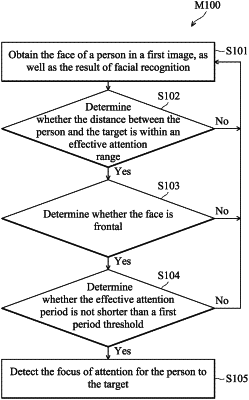| CPC A61B 5/168 (2013.01) [A61B 5/1176 (2013.01); A61B 5/7246 (2013.01); A61B 5/7264 (2013.01); G06V 40/16 (2022.01); G06V 40/165 (2022.01); G06V 40/168 (2022.01); G06V 40/169 (2022.01); G06V 40/173 (2022.01)] | 18 Claims |

|
1. A computer-implemented method for detecting a focus of attention, comprising:
obtaining a face of a person in a first image, as well as the result of facial recognition of the face, wherein the result of facial recognition comprises a face candidate box and a plurality of facial attributes;
determining whether a distance between the person and a target is within an effective attention range based on the face candidate box;
obtaining a plurality of keypoints of the face based on the face candidate box and performing a frontal determination process according to the keypoints, so as to determine whether the face is frontal, in response to the distance between the person and the target being within the effective attention range;
performing an effective-attention-period calculation process based on a series of first images obtained in multiple time points in the past, so as to obtain an effective attention period for the person to the target, and thereby determining whether the effective attention period is not shorter than a period threshold, in response to the face being frontal; and
performing a focus-of-attention calculation process based on the target's size, the keypoints, and the face candidate box after determining that the effective attention period is not shorter than a period threshold, so as to obtain the focus of attention for the person to the target.
|